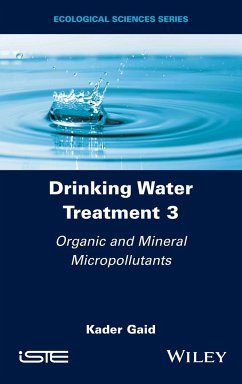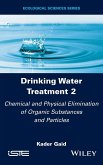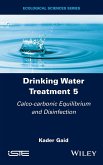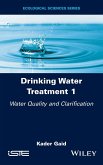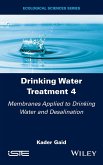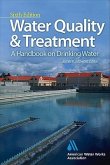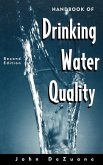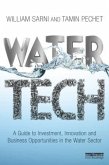Kader Gaid
Drinking Water Treatment, Organic and Mineral Micropollutants
Kader Gaid
Drinking Water Treatment, Organic and Mineral Micropollutants
- Gebundenes Buch
- Merkliste
- Auf die Merkliste
- Bewerten Bewerten
- Teilen
- Produkt teilen
- Produkterinnerung
- Produkterinnerung
Today, hundreds of millions of people drink contaminated water without knowing it. Yet water treatment technologies can effectively eliminate contamination and can supply urban and rural populations with safe drinking water in a secure way. For almost two centuries, the huge number of treatments available to guarantee water quality has grown alongside technological progress, the strengthening of industry norms and the reinforcement of consumer expectations. New treatment methods have been developed according to the advancement of knowledge and new sanitary regulations. This five-volume book…mehr
Andere Kunden interessierten sich auch für
![Drinking Water Treatment, Chemical and Physical Elimination of Organic Substances and Particles Drinking Water Treatment, Chemical and Physical Elimination of Organic Substances and Particles]() Kader GaidDrinking Water Treatment, Chemical and Physical Elimination of Organic Substances and Particles173,99 €
Kader GaidDrinking Water Treatment, Chemical and Physical Elimination of Organic Substances and Particles173,99 €![Drinking Water Treatment, Calco-Carbonic Equilibrium and Disinfection Drinking Water Treatment, Calco-Carbonic Equilibrium and Disinfection]() Kader GaidDrinking Water Treatment, Calco-Carbonic Equilibrium and Disinfection173,99 €
Kader GaidDrinking Water Treatment, Calco-Carbonic Equilibrium and Disinfection173,99 €![Drinking Water Treatment, Water Quality and Clarification Drinking Water Treatment, Water Quality and Clarification]() Kader GaidDrinking Water Treatment, Water Quality and Clarification172,99 €
Kader GaidDrinking Water Treatment, Water Quality and Clarification172,99 €![Drinking Water Treatment, Membranes Applied to Drinking Water and Desalination Drinking Water Treatment, Membranes Applied to Drinking Water and Desalination]() Kader GaidDrinking Water Treatment, Membranes Applied to Drinking Water and Desalination173,99 €
Kader GaidDrinking Water Treatment, Membranes Applied to Drinking Water and Desalination173,99 €![Water Quality & Treatment: A Handbook on Drinking Water Water Quality & Treatment: A Handbook on Drinking Water]() James K. EdzwaldWater Quality & Treatment: A Handbook on Drinking Water190,99 €
James K. EdzwaldWater Quality & Treatment: A Handbook on Drinking Water190,99 €![Handbook of Drinking Water Quality Handbook of Drinking Water Quality]() John DezuaneHandbook of Drinking Water Quality193,99 €
John DezuaneHandbook of Drinking Water Quality193,99 €![Water Tech Water Tech]() William SarniWater Tech197,99 €
William SarniWater Tech197,99 €-
-
-
Today, hundreds of millions of people drink contaminated water without knowing it. Yet water treatment technologies can effectively eliminate contamination and can supply urban and rural populations with safe drinking water in a secure way. For almost two centuries, the huge number of treatments available to guarantee water quality has grown alongside technological progress, the strengthening of industry norms and the reinforcement of consumer expectations. New treatment methods have been developed according to the advancement of knowledge and new sanitary regulations. This five-volume book sets out to clearly present the variety of treatments available along with their performance, limitations and conditions of use as well as ways to combine them to produce safe drinking water, which is a basic need essential to everyday life. The author shares his expertise acquired at Veolia, a company that is a world leader in water services and sanitation, desalination of sea water and the recycling of wastewater. Founded in France in 1853 to bring safe water to populations and to protect them from waterborne epidemics which ravaged cities, its history is intertwined with that of water treatment.
Hinweis: Dieser Artikel kann nur an eine deutsche Lieferadresse ausgeliefert werden.
Hinweis: Dieser Artikel kann nur an eine deutsche Lieferadresse ausgeliefert werden.
Produktdetails
- Produktdetails
- Verlag: Wiley
- Volume 3 edition
- Seitenzahl: 464
- Erscheinungstermin: 15. August 2023
- Englisch
- Abmessung: 240mm x 161mm x 29mm
- Gewicht: 842g
- ISBN-13: 9781786307859
- ISBN-10: 1786307855
- Artikelnr.: 68214540
- Herstellerkennzeichnung
- Libri GmbH
- Europaallee 1
- 36244 Bad Hersfeld
- gpsr@libri.de
- Verlag: Wiley
- Volume 3 edition
- Seitenzahl: 464
- Erscheinungstermin: 15. August 2023
- Englisch
- Abmessung: 240mm x 161mm x 29mm
- Gewicht: 842g
- ISBN-13: 9781786307859
- ISBN-10: 1786307855
- Artikelnr.: 68214540
- Herstellerkennzeichnung
- Libri GmbH
- Europaallee 1
- 36244 Bad Hersfeld
- gpsr@libri.de
Kader Gaid is a doctor of physical sciences, specifically environmental process engineering. A professor and researcher at the Alger University of Science and Technology Houari Boumédiène (Algeria), he has been an expert in drinking water at the worldwide company Veolia for over 25 years.
Chapter 10 Removal of Micropollutants 1
10.1 Introduction 1
10.2 Pesticides 2
10.3 Pharmaceuticals and industrial waste 4
10.4 Pesticide removal technologies and emerging MPs 12
10.4.1 Adsorption onto activated carbon (AC) 13
10.4.2 Ozonation 51
10.4.3 Ozone-activated carbon combination 66
10.4.4 Advanced chemical oxidation 71
10.4.5 Nanofiltration and reverse osmosis membranes 80
10.5 Frogbox ® : an effective monitoring and control tool 95
10.6 The evolution of micropollutants in drinking water plants 97
10.7 References 99
Chapter 11 Removal of Perfluorinated Compounds 105
11.1 Physicochemical properties 106
11.2 Presence in the water 108
11.3 Drinking water regulations 108
11.4 Treatments 108
11.4.1 Coagulation-flocculation-settling (or flotation) 108
11.4.2 Chemical oxidation 109
11.4.3 UV oxidation 109
11.4.4 Activated carbon 109
11.4.5. High-pressure membranes: nanofiltration and reverse osmosis .. 115
11.5 Conclusion 120
11.6 References 121
Chapter 12 Biological Removal of Ammonia 125
12.1 The principle of biological nitrification 125
12.2 Design parameters 127
12.2.1 Dissolved oxygen 127
12.2.2 Filtration rate 129
12.2.3. NH + 4 concentration removed as a function of temperature (°C). 129
12.2.4 Applicable volume load 129
12.2.5 Contact time 131
12.2.6 Material height 131
12.3 Factors limiting oxygen 131
12.3.1 Mineral carbon 131
12.3.2 pH 132
12.3.3 Temperature 132
12.3.4 Other elements 133
12.3.5 Biological filter washing 133
12.4 Implementation 134
12.4.1 Sand filtration 134
12.5 Biofilters (Biocarbon ® process) 137
12.6 Water treatment stations 140
12.6.1 Treatment stations with conventional sand, dual media or GAC
filtration 140
12.6.2 Treatment stations with Biocarbon ® filters 143
12.7 References 146
Chapter 13 Nitrate Removal 149
13.1 Biological treatment 150
13.1.1 Biochemical reactions 151
13.1.2 Nitrite formation 153
13.1.3 The bacteriological aspect 154
13.1.4 Biofilter description (Biodenit ® process) 154
13.1.5 Water treatment stations including biological denitrification 159
13.1.6 Factors affecting biological denitrification 163
13.1.7 Design parameters: applied volumic load 166
13.1.8 Design parameters: minimum contact time (tc min) 167
13.1.9 Design parameters: height of Biodagen ® material (m) 167
13.1.10 Design parameters: material volume (m 3) 168
13.1.11 Partial treatment 168
13.1.12 Sludge production 170
13.1.13 The reagents 170
13.1.14 Biological denitrification implementation and exploitation 174
13.2 Treatment with ion exchange resins 175
13.2.1 General exchange mechanism (Ecodenit ® process) 176
13.2.2 Ecodenit ® process technology 180
13.2.3 Integration into the water treatment station 187
13.2.4 Packaged solutions 188
13.3 Nitrate removal by high pressure membranes 188
13.4 References 194
Chapter 14 Removal of Perchlorates 199
14.1 General aspects 200
14.2 Main processes for removing perchlorate ions 200
14.2.1 Ion exchange resins 201
14.2.2 Nanofiltration membranes 208
14.3 Conclusions regarding the removal of perchlorates 211
14.4 References 212
Chapter 15 Water Softening 215
15.1 Water hardness 215
15.2 Alkalinity 216
15.3 Langelier index (LI or LSI) 220
15.4 Drinking water hardness goals 220
15.5 General principles of water softening 221
15.5.1 The main chemical reactions with lime and soda 224
15.6 Water softening chemical processes 233
15.6.1 Limitations of the process and empirical considerations 234
15.7 Veolia water softening technologies 235
15.7.1 Clariflocculator 235
15.7.2 Actiflo ® softening 238
15.7.3 Multiflo ® softening 243
15.7.4 Catalytic water softening 248
15.8 Saphira ® process 283
15.9 Water softening using high-pressure membranes 286
15.10 Water softening using ion exchange resins 286
15.10.1 Resin resistance: use precautions 287
15.10.2 Ca 2+ and Mg 2+ removal 288
15.10.3 Bicarbonate removal 289
15.10.4 Resin operating capacity 290
15.10.5 Operating parameters 290
15.11. Comparison between the four water softening solutions discussed 292
15.11.1 Advantages and limitations of the different solutions 292
15.12 References 293
Chapter 16 Metal Removal 297
16.1 Iron and manganese removal: general aspects 297
16.1.1 Presence of iron and manganese at the resource level 297
16.1.2 Presence of iron and manganese at the production level 299
16.1.3 Regulatory aspects of iron and manganese 301
16.1.4 Iron and manganese treatments 302
16.2 Arsenic removal 356
16.2.1 Arsenic chemistry 357
16.2.2 Arsenic treatments 360
16.3 Removal of selenium (Se) 391
16.3.1 The chemistry of selenium 392
16.3.2 Selenium removal treatments 394
16.4 Nickel removal 402
16.4.1 The chemistry of nickel 402
16.4.2 Nickel removal treatment 403
16.5 References 412
Index 423
Summaries of other volumes 425
10.1 Introduction 1
10.2 Pesticides 2
10.3 Pharmaceuticals and industrial waste 4
10.4 Pesticide removal technologies and emerging MPs 12
10.4.1 Adsorption onto activated carbon (AC) 13
10.4.2 Ozonation 51
10.4.3 Ozone-activated carbon combination 66
10.4.4 Advanced chemical oxidation 71
10.4.5 Nanofiltration and reverse osmosis membranes 80
10.5 Frogbox ® : an effective monitoring and control tool 95
10.6 The evolution of micropollutants in drinking water plants 97
10.7 References 99
Chapter 11 Removal of Perfluorinated Compounds 105
11.1 Physicochemical properties 106
11.2 Presence in the water 108
11.3 Drinking water regulations 108
11.4 Treatments 108
11.4.1 Coagulation-flocculation-settling (or flotation) 108
11.4.2 Chemical oxidation 109
11.4.3 UV oxidation 109
11.4.4 Activated carbon 109
11.4.5. High-pressure membranes: nanofiltration and reverse osmosis .. 115
11.5 Conclusion 120
11.6 References 121
Chapter 12 Biological Removal of Ammonia 125
12.1 The principle of biological nitrification 125
12.2 Design parameters 127
12.2.1 Dissolved oxygen 127
12.2.2 Filtration rate 129
12.2.3. NH + 4 concentration removed as a function of temperature (°C). 129
12.2.4 Applicable volume load 129
12.2.5 Contact time 131
12.2.6 Material height 131
12.3 Factors limiting oxygen 131
12.3.1 Mineral carbon 131
12.3.2 pH 132
12.3.3 Temperature 132
12.3.4 Other elements 133
12.3.5 Biological filter washing 133
12.4 Implementation 134
12.4.1 Sand filtration 134
12.5 Biofilters (Biocarbon ® process) 137
12.6 Water treatment stations 140
12.6.1 Treatment stations with conventional sand, dual media or GAC
filtration 140
12.6.2 Treatment stations with Biocarbon ® filters 143
12.7 References 146
Chapter 13 Nitrate Removal 149
13.1 Biological treatment 150
13.1.1 Biochemical reactions 151
13.1.2 Nitrite formation 153
13.1.3 The bacteriological aspect 154
13.1.4 Biofilter description (Biodenit ® process) 154
13.1.5 Water treatment stations including biological denitrification 159
13.1.6 Factors affecting biological denitrification 163
13.1.7 Design parameters: applied volumic load 166
13.1.8 Design parameters: minimum contact time (tc min) 167
13.1.9 Design parameters: height of Biodagen ® material (m) 167
13.1.10 Design parameters: material volume (m 3) 168
13.1.11 Partial treatment 168
13.1.12 Sludge production 170
13.1.13 The reagents 170
13.1.14 Biological denitrification implementation and exploitation 174
13.2 Treatment with ion exchange resins 175
13.2.1 General exchange mechanism (Ecodenit ® process) 176
13.2.2 Ecodenit ® process technology 180
13.2.3 Integration into the water treatment station 187
13.2.4 Packaged solutions 188
13.3 Nitrate removal by high pressure membranes 188
13.4 References 194
Chapter 14 Removal of Perchlorates 199
14.1 General aspects 200
14.2 Main processes for removing perchlorate ions 200
14.2.1 Ion exchange resins 201
14.2.2 Nanofiltration membranes 208
14.3 Conclusions regarding the removal of perchlorates 211
14.4 References 212
Chapter 15 Water Softening 215
15.1 Water hardness 215
15.2 Alkalinity 216
15.3 Langelier index (LI or LSI) 220
15.4 Drinking water hardness goals 220
15.5 General principles of water softening 221
15.5.1 The main chemical reactions with lime and soda 224
15.6 Water softening chemical processes 233
15.6.1 Limitations of the process and empirical considerations 234
15.7 Veolia water softening technologies 235
15.7.1 Clariflocculator 235
15.7.2 Actiflo ® softening 238
15.7.3 Multiflo ® softening 243
15.7.4 Catalytic water softening 248
15.8 Saphira ® process 283
15.9 Water softening using high-pressure membranes 286
15.10 Water softening using ion exchange resins 286
15.10.1 Resin resistance: use precautions 287
15.10.2 Ca 2+ and Mg 2+ removal 288
15.10.3 Bicarbonate removal 289
15.10.4 Resin operating capacity 290
15.10.5 Operating parameters 290
15.11. Comparison between the four water softening solutions discussed 292
15.11.1 Advantages and limitations of the different solutions 292
15.12 References 293
Chapter 16 Metal Removal 297
16.1 Iron and manganese removal: general aspects 297
16.1.1 Presence of iron and manganese at the resource level 297
16.1.2 Presence of iron and manganese at the production level 299
16.1.3 Regulatory aspects of iron and manganese 301
16.1.4 Iron and manganese treatments 302
16.2 Arsenic removal 356
16.2.1 Arsenic chemistry 357
16.2.2 Arsenic treatments 360
16.3 Removal of selenium (Se) 391
16.3.1 The chemistry of selenium 392
16.3.2 Selenium removal treatments 394
16.4 Nickel removal 402
16.4.1 The chemistry of nickel 402
16.4.2 Nickel removal treatment 403
16.5 References 412
Index 423
Summaries of other volumes 425
Chapter 10 Removal of Micropollutants 1
10.1 Introduction 1
10.2 Pesticides 2
10.3 Pharmaceuticals and industrial waste 4
10.4 Pesticide removal technologies and emerging MPs 12
10.4.1 Adsorption onto activated carbon (AC) 13
10.4.2 Ozonation 51
10.4.3 Ozone-activated carbon combination 66
10.4.4 Advanced chemical oxidation 71
10.4.5 Nanofiltration and reverse osmosis membranes 80
10.5 Frogbox ® : an effective monitoring and control tool 95
10.6 The evolution of micropollutants in drinking water plants 97
10.7 References 99
Chapter 11 Removal of Perfluorinated Compounds 105
11.1 Physicochemical properties 106
11.2 Presence in the water 108
11.3 Drinking water regulations 108
11.4 Treatments 108
11.4.1 Coagulation-flocculation-settling (or flotation) 108
11.4.2 Chemical oxidation 109
11.4.3 UV oxidation 109
11.4.4 Activated carbon 109
11.4.5. High-pressure membranes: nanofiltration and reverse osmosis .. 115
11.5 Conclusion 120
11.6 References 121
Chapter 12 Biological Removal of Ammonia 125
12.1 The principle of biological nitrification 125
12.2 Design parameters 127
12.2.1 Dissolved oxygen 127
12.2.2 Filtration rate 129
12.2.3. NH + 4 concentration removed as a function of temperature (°C). 129
12.2.4 Applicable volume load 129
12.2.5 Contact time 131
12.2.6 Material height 131
12.3 Factors limiting oxygen 131
12.3.1 Mineral carbon 131
12.3.2 pH 132
12.3.3 Temperature 132
12.3.4 Other elements 133
12.3.5 Biological filter washing 133
12.4 Implementation 134
12.4.1 Sand filtration 134
12.5 Biofilters (Biocarbon ® process) 137
12.6 Water treatment stations 140
12.6.1 Treatment stations with conventional sand, dual media or GAC
filtration 140
12.6.2 Treatment stations with Biocarbon ® filters 143
12.7 References 146
Chapter 13 Nitrate Removal 149
13.1 Biological treatment 150
13.1.1 Biochemical reactions 151
13.1.2 Nitrite formation 153
13.1.3 The bacteriological aspect 154
13.1.4 Biofilter description (Biodenit ® process) 154
13.1.5 Water treatment stations including biological denitrification 159
13.1.6 Factors affecting biological denitrification 163
13.1.7 Design parameters: applied volumic load 166
13.1.8 Design parameters: minimum contact time (tc min) 167
13.1.9 Design parameters: height of Biodagen ® material (m) 167
13.1.10 Design parameters: material volume (m 3) 168
13.1.11 Partial treatment 168
13.1.12 Sludge production 170
13.1.13 The reagents 170
13.1.14 Biological denitrification implementation and exploitation 174
13.2 Treatment with ion exchange resins 175
13.2.1 General exchange mechanism (Ecodenit ® process) 176
13.2.2 Ecodenit ® process technology 180
13.2.3 Integration into the water treatment station 187
13.2.4 Packaged solutions 188
13.3 Nitrate removal by high pressure membranes 188
13.4 References 194
Chapter 14 Removal of Perchlorates 199
14.1 General aspects 200
14.2 Main processes for removing perchlorate ions 200
14.2.1 Ion exchange resins 201
14.2.2 Nanofiltration membranes 208
14.3 Conclusions regarding the removal of perchlorates 211
14.4 References 212
Chapter 15 Water Softening 215
15.1 Water hardness 215
15.2 Alkalinity 216
15.3 Langelier index (LI or LSI) 220
15.4 Drinking water hardness goals 220
15.5 General principles of water softening 221
15.5.1 The main chemical reactions with lime and soda 224
15.6 Water softening chemical processes 233
15.6.1 Limitations of the process and empirical considerations 234
15.7 Veolia water softening technologies 235
15.7.1 Clariflocculator 235
15.7.2 Actiflo ® softening 238
15.7.3 Multiflo ® softening 243
15.7.4 Catalytic water softening 248
15.8 Saphira ® process 283
15.9 Water softening using high-pressure membranes 286
15.10 Water softening using ion exchange resins 286
15.10.1 Resin resistance: use precautions 287
15.10.2 Ca 2+ and Mg 2+ removal 288
15.10.3 Bicarbonate removal 289
15.10.4 Resin operating capacity 290
15.10.5 Operating parameters 290
15.11. Comparison between the four water softening solutions discussed 292
15.11.1 Advantages and limitations of the different solutions 292
15.12 References 293
Chapter 16 Metal Removal 297
16.1 Iron and manganese removal: general aspects 297
16.1.1 Presence of iron and manganese at the resource level 297
16.1.2 Presence of iron and manganese at the production level 299
16.1.3 Regulatory aspects of iron and manganese 301
16.1.4 Iron and manganese treatments 302
16.2 Arsenic removal 356
16.2.1 Arsenic chemistry 357
16.2.2 Arsenic treatments 360
16.3 Removal of selenium (Se) 391
16.3.1 The chemistry of selenium 392
16.3.2 Selenium removal treatments 394
16.4 Nickel removal 402
16.4.1 The chemistry of nickel 402
16.4.2 Nickel removal treatment 403
16.5 References 412
Index 423
Summaries of other volumes 425
10.1 Introduction 1
10.2 Pesticides 2
10.3 Pharmaceuticals and industrial waste 4
10.4 Pesticide removal technologies and emerging MPs 12
10.4.1 Adsorption onto activated carbon (AC) 13
10.4.2 Ozonation 51
10.4.3 Ozone-activated carbon combination 66
10.4.4 Advanced chemical oxidation 71
10.4.5 Nanofiltration and reverse osmosis membranes 80
10.5 Frogbox ® : an effective monitoring and control tool 95
10.6 The evolution of micropollutants in drinking water plants 97
10.7 References 99
Chapter 11 Removal of Perfluorinated Compounds 105
11.1 Physicochemical properties 106
11.2 Presence in the water 108
11.3 Drinking water regulations 108
11.4 Treatments 108
11.4.1 Coagulation-flocculation-settling (or flotation) 108
11.4.2 Chemical oxidation 109
11.4.3 UV oxidation 109
11.4.4 Activated carbon 109
11.4.5. High-pressure membranes: nanofiltration and reverse osmosis .. 115
11.5 Conclusion 120
11.6 References 121
Chapter 12 Biological Removal of Ammonia 125
12.1 The principle of biological nitrification 125
12.2 Design parameters 127
12.2.1 Dissolved oxygen 127
12.2.2 Filtration rate 129
12.2.3. NH + 4 concentration removed as a function of temperature (°C). 129
12.2.4 Applicable volume load 129
12.2.5 Contact time 131
12.2.6 Material height 131
12.3 Factors limiting oxygen 131
12.3.1 Mineral carbon 131
12.3.2 pH 132
12.3.3 Temperature 132
12.3.4 Other elements 133
12.3.5 Biological filter washing 133
12.4 Implementation 134
12.4.1 Sand filtration 134
12.5 Biofilters (Biocarbon ® process) 137
12.6 Water treatment stations 140
12.6.1 Treatment stations with conventional sand, dual media or GAC
filtration 140
12.6.2 Treatment stations with Biocarbon ® filters 143
12.7 References 146
Chapter 13 Nitrate Removal 149
13.1 Biological treatment 150
13.1.1 Biochemical reactions 151
13.1.2 Nitrite formation 153
13.1.3 The bacteriological aspect 154
13.1.4 Biofilter description (Biodenit ® process) 154
13.1.5 Water treatment stations including biological denitrification 159
13.1.6 Factors affecting biological denitrification 163
13.1.7 Design parameters: applied volumic load 166
13.1.8 Design parameters: minimum contact time (tc min) 167
13.1.9 Design parameters: height of Biodagen ® material (m) 167
13.1.10 Design parameters: material volume (m 3) 168
13.1.11 Partial treatment 168
13.1.12 Sludge production 170
13.1.13 The reagents 170
13.1.14 Biological denitrification implementation and exploitation 174
13.2 Treatment with ion exchange resins 175
13.2.1 General exchange mechanism (Ecodenit ® process) 176
13.2.2 Ecodenit ® process technology 180
13.2.3 Integration into the water treatment station 187
13.2.4 Packaged solutions 188
13.3 Nitrate removal by high pressure membranes 188
13.4 References 194
Chapter 14 Removal of Perchlorates 199
14.1 General aspects 200
14.2 Main processes for removing perchlorate ions 200
14.2.1 Ion exchange resins 201
14.2.2 Nanofiltration membranes 208
14.3 Conclusions regarding the removal of perchlorates 211
14.4 References 212
Chapter 15 Water Softening 215
15.1 Water hardness 215
15.2 Alkalinity 216
15.3 Langelier index (LI or LSI) 220
15.4 Drinking water hardness goals 220
15.5 General principles of water softening 221
15.5.1 The main chemical reactions with lime and soda 224
15.6 Water softening chemical processes 233
15.6.1 Limitations of the process and empirical considerations 234
15.7 Veolia water softening technologies 235
15.7.1 Clariflocculator 235
15.7.2 Actiflo ® softening 238
15.7.3 Multiflo ® softening 243
15.7.4 Catalytic water softening 248
15.8 Saphira ® process 283
15.9 Water softening using high-pressure membranes 286
15.10 Water softening using ion exchange resins 286
15.10.1 Resin resistance: use precautions 287
15.10.2 Ca 2+ and Mg 2+ removal 288
15.10.3 Bicarbonate removal 289
15.10.4 Resin operating capacity 290
15.10.5 Operating parameters 290
15.11. Comparison between the four water softening solutions discussed 292
15.11.1 Advantages and limitations of the different solutions 292
15.12 References 293
Chapter 16 Metal Removal 297
16.1 Iron and manganese removal: general aspects 297
16.1.1 Presence of iron and manganese at the resource level 297
16.1.2 Presence of iron and manganese at the production level 299
16.1.3 Regulatory aspects of iron and manganese 301
16.1.4 Iron and manganese treatments 302
16.2 Arsenic removal 356
16.2.1 Arsenic chemistry 357
16.2.2 Arsenic treatments 360
16.3 Removal of selenium (Se) 391
16.3.1 The chemistry of selenium 392
16.3.2 Selenium removal treatments 394
16.4 Nickel removal 402
16.4.1 The chemistry of nickel 402
16.4.2 Nickel removal treatment 403
16.5 References 412
Index 423
Summaries of other volumes 425

